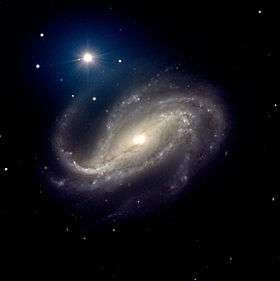NGC 613
| NGC 613 | |
|---|---|
|
NGC 613 imaged from the Paranal Observatory in Chile.[1] The prominent star at upper left is HD 9693.[2] | |
| Observation data (J2000 epoch) | |
| Constellation | Sculptor |
| Right ascension | 01h 34m 18.235s[3] |
| Declination | –29° 25′ 06.56″[3] |
| Helio radial velocity | +1,487[4] |
| Distance | 67.5 Mly (20.7 Mpc)[5] |
| Type | SBbc(rs)[6] |
| Apparent dimensions (V) | 5′.2 × 2′.6[7] |
| Apparent magnitude (V) | 10.0[7] |
NGC 613 is a barred spiral galaxy located some 67[5] million light years away in the southern constellation of Sculptor.[8] It is a candidate outlying member of the Sculptor Group, a gravitationally-bound group of galaxies.[7] This galaxy was discovered in 1798 by German-English astronomer William Herschel, then re-discovered and catalogued by Scottish astronomer James Dunlop. It was first photographed in 1912, which revealed the spiral form of the nebula.[7] During the twentieth century, radio telescope observations showed that a linear feature in the nucleus was a relatively strong source of radio emission.[9]
NGC 613 is inclined by an angle of 37° to the line of sight from the Earth along a position angle of 125°.[10] The morphological classification of NGC 613 is SBbc(rs),[6] indicating that it is a spiral galaxy with a bar across the nucleus (SB), a weak inner ring structure circling the bar (rs), and moderate to loosely wound spiral arms (bc).[11] The bar is relatively broad but irregular in profile with a position angle that varies from 115–124° and dust lanes located along the leading edges. Star formation is occurring at the ends of the bar and extending along the well-defined spiral arms. The central bulge is readily apparent, with a radius of 14″.[10]
The classification of the nucleus is of type HII, indicating a match to the spectrum of an H II region. Near the core, the stars have a velocity dispersion of 136 ± 20 km/s. The nucleus is a source of radio emission with the form of an inner ring with a radius of about 1,100 ly (350 pc) and a linear feature that is perhaps perpendicular to it. The latter consists of three discrete blobs spanning approximately 2,000 ly (600 pc).[12] Observations suggest the presence of a supermassive black hole at the core with a mass in the range (1.9–9.6) × 107 times the mass of the Sun.[6]
Gallery
-

NGC 613 image from Hubble Space Telescope.[1]
-

Broadband image from the Mount Lemmon SkyCenter using the 0.8m Schulman Telescope
- ^ "A spiral galaxy’s brights and darks". Retrieved 1 October 2015.
References
- ↑ Nemiroff, Robert; Bonnell, Jerry (February 13, 2004), "NGC 613: Spiral of Dust and Stars", Astronomy Picture of the Day (NASA), retrieved 2013-07-07.
- ↑ "HD 9693 -- Star", SIMBAD (Centre de Données astronomiques de Strasbourg), retrieved 2013-07-07.
- 1 2 Skrutskie, M. F.; et al. (February 2006), "The Two Micron All Sky Survey (2MASS)", Astrophysical Journal 131 (2): 1163–1183, Bibcode:2006AJ....131.1163S, doi:10.1086/498708.
- ↑ da Costa, L. Nicolaci; et al. (July 1998), "The Southern Sky Redshift Survey", Astrophysical Journal 116 (1): 1–7, arXiv:astro-ph/9804064, Bibcode:1998AJ....116....1D, doi:10.1086/300410.
- 1 2 Meurer, Gerhardt R.; et al. (July 2006), "The Survey for Ionization in Neutral Gas Galaxies. I. Description and Initial Results", The Astrophysical Journal Supplement Series 165 (1): 307–337, arXiv:astro-ph/0604444, Bibcode:2006ApJS..165..307M, doi:10.1086/504685.
- 1 2 3 Beifiori, A.; et al. (February 2009), "Upper Limits on the Masses of 105 Supermassive Black Holes from Hubble Space Telescope/Space Telescope Imaging Spectrograph Archival Data", The Astrophysical Journal 692 (1): 856–868, arXiv:0809.5103, Bibcode:2009ApJ...692..856B, doi:10.1088/0004-637X/692/1/856.
- 1 2 3 4 O'Meara, Stephen James (2013), Deep-Sky Companions: Southern Gems, Cambridge University Press, pp. 36–43, ISBN 1107015014.
- ↑ West, Richard (December 19, 2003), Three Dusty Beauties, European Southern Observatory, retrieved 2013-07-07.
- ↑ Hummel, E.; et al. (January 1987), "The central region of NGC 613. Evidence for an accelerated collimated outflow", Astronomy and Astrophysics 172 (1–2): 51–54, Bibcode:1987A&A...172...51H.
- 1 2 Baumgart, C. W.; Peterson, C. J. (January 1986), "Near-infrared surface photometry of barred spiral galaxies", Publications of the Astronomical Society of the Pacific 98: 56–69, Bibcode:1986PASP...98...56B, doi:10.1086/131721.
- ↑ Buta, Ronald J.; et al. (2007), Atlas of Galaxies, Cambridge University Press, pp. 13–17, ISBN 0521820480.
- ↑ Hummel, E.; Jorsater, S. (July 1992), "The central region of NGC 613 revisited", Astronomy and Astrophysics 261 (1): 85–93, Bibcode:1992A&A...261...85H.
External links
| Wikimedia Commons has media related to NGC 613. |
- NGC 613 on WikiSky: DSS2, SDSS, GALEX, IRAS, Hydrogen α, X-Ray, Astrophoto, Sky Map, Articles and images
Coordinates: ![]() 01h 34m 18.235s, −29° 25′ 06.56″
01h 34m 18.235s, −29° 25′ 06.56″
| ||||||||||
